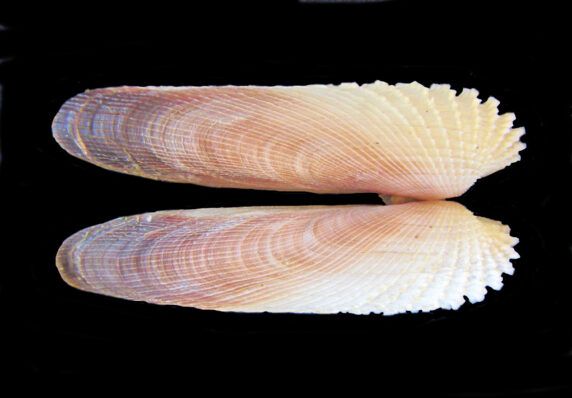Angel Wing Shell of the Pholadidae Family
 Pacific Coast Angel Wing Shell, Pholas chiloensis
Pacific Coast Angel Wing Shell, Pholas chiloensis
Angel Wings, also known as Piddock Shells in the Pholadidae Family are equivalve, slightly inflated, fragile, thin shells that are composed of aragonite and may have an elongated, globular oval or quadrate profile. They have exterior sculpting that varies between species and by section of an individual. They are divided into two or three sections by different texture. The sculpting includes reticulated (net-like) spiny, and imbricated (overlapping plates) concentric ridges. This sculpting allow the shells to mechanically abrade the substrate in which they reside. The living animals in most family members does not fit within the shell and it burrows into clay, coral, mud, rock, shale, shells and wood for protection. The hinge, which lacks teeth, muscular attachments, and other aspects of the shell are modified to allow it to move in a circular, rasping motion to facilitate burrowing. The Angel Wings are white to brownish in color and some have the ability to bio-luminescence. Angel Wing Shells can reach a maximum of 18 cm (7.1 inches) in length and 4.7 cm (1.8 inches) in height.
Angel Shells are found intertidally to depths up to 300 m (984 feet) but the majority are found in water that is less than 100 m (328 feet) deep. They spend their entire adult life within their burrow which may be up to one meter in length. They utilize their extended siphon to feed on suspended plankton and other organic matter. In turn they are preyed upon by crabs and gastropods. There are twenty-four members of the Pholadidae Family that are found globally in temperate and tropical seas of which eight are found around along Mexico’s west coast.